193rd Infantry Brigade (United States)
| 193rd Infantry Brigade | |
|---|---|
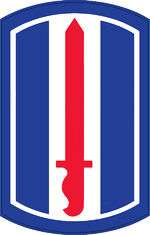 Shoulder sleeve insignia | |
| Active |
1922–1946 1962–1994 2007–present |
| Country |
|
| Branch |
|
| Role | Training |
| Size | Brigade |
| Garrison/HQ | Fort Jackson, South Carolina |
| Motto(s) | "No Ground to Give" |
| March | Pathfinder of Panama, by John Philip Sousa |
| Battle honours |
Central Europe Operation Just Cause |
| Insignia | |
| Distinctive unit insignia |
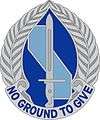 |
The 193rd Infantry Brigade is a United States Army infantry brigade, which was originally constituted in the Army's organized reserves on 24 June 1922 as Headquarters and Headquarters Company, 193rd Infantry Brigade and assigned to the 97th Division. The brigade was reorganized and reconstituted in February 1942 as the 97th Reconnaissance Troop, 97th Division. In February 1943, the Troop was ordered to active military service and organized at Camp Swift, Texas. Reorganized and redesignated October 1945 as the 97th Mechanized Cavalry Reconnaissance Troop.
World War II
The 97th Reconnaissance Troop landed at Le Havre, France, 2 March 1945 as part of the 97th Infantry Division. The Division crossed the German border west of Aachen and took up a defensive position along the west bank of the Rhine River opposite Düsseldorf, engaging in patrolling. The division then entered the battle of the Ruhr pocket, crossing the Rhine near Bonn and taking up a position on the southern bank of the Siege River. It crossed that river against light resistance and fought a street-to-street engagement in Siegburg. Pushing on toward Düsseldorf through difficult terrain and heavy resistance in densely wooded areas, the Division captured Solingen. Düsseldorf fell on the next day and the Ruhr pocket was eliminated. 97th Reconnaissance Troop played a vital role in the Ruhr campaign. Besides its customary reconnaissance and patrolling duties, the unit once was charged with protecting the entire left flank of the division.
Moving to protect the left flank of the Third Army on its southern drive, the 97th Division took Cheb, Czechoslovakia and attacked the Czechoslovak pocket near Weiden, Germany. It had advanced to Konstantinovy Lázně, Czechoslovakia, when it received the cease-fire order on 7 May 1945. The Division left for Le Havre, 16 June 1945, for redeployment to the Pacific, arriving at Cebu, Philippines, 16 September, and then sailed to Japan for occupation duty, arriving at Yokohama 23 September.
97th Mechanized Reconnaissance Troop inactivated March 1946 in Japan. (Organized Reserves redesignated 25 March 1948 as the Organized Reserve Corps; redesignated 9 July 1952 as the Army Reserve.) Converted and redesignated July 1962 as Headquarters and Headquarters Company, 193rd Infantry Brigade and relieved from assignment to the 97th Infantry Division.
Panama
In 1961, after the abortive Bay of Pigs Invasion and rumors of Soviet assistance to Cuba, Secretary of Defense Robert McNamara decided to bolster available U.S. Army forces in the Caribbean area. The Army replaced the battle group in the Panama Canal Zone with the 193d Infantry Brigade, which was activated on 8 August 1962.[1]
Through most of the period of its assignment to the Canal Zone, the 193d included the following units:
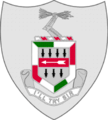 3d Battalion, 5th Infantry (Instead of the regiment's common nickname, the "Bobcats," 3rd Battalion retained the name and motto, "Red Devils," when reflagged from 3d Battalion (Airborne), 508th Infantry, Fort Kobbe)
3d Battalion, 5th Infantry (Instead of the regiment's common nickname, the "Bobcats," 3rd Battalion retained the name and motto, "Red Devils," when reflagged from 3d Battalion (Airborne), 508th Infantry, Fort Kobbe) 4th Battalion, 10th Infantry ("Apaches," Fort Davis)
4th Battalion, 10th Infantry ("Apaches," Fort Davis) 4th Battalion, 20th Infantry ("Sykes Regulars," Fort Clayton)
4th Battalion, 20th Infantry ("Sykes Regulars," Fort Clayton)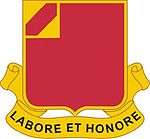 Battery B, 22d Field Artillery (Fort Kobbe; later reflagged as Battery D, 320th FA)
Battery B, 22d Field Artillery (Fort Kobbe; later reflagged as Battery D, 320th FA) 518th Engineer Company (Fort Kobbe, later reflagged as the 59th Engineer Company)
518th Engineer Company (Fort Kobbe, later reflagged as the 59th Engineer Company) 534th MP Company (Fort Clayton)
534th MP Company (Fort Clayton) 549th Military Police Company (Fort Gulick)
549th Military Police Company (Fort Gulick)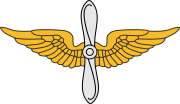 210th Aviation Battalion (Albrook Army Air Field; moved during the 1970s to Fort Kobbe as part of the Canal reorganization treaties)
210th Aviation Battalion (Albrook Army Air Field; moved during the 1970s to Fort Kobbe as part of the Canal reorganization treaties) 1097th Transportation Company (Medium Boat) (Fort Davis)
1097th Transportation Company (Medium Boat) (Fort Davis)
Additionally, there were other units, such as the School of the Americas (Fort Gulick), 3d Battalion, 7th Special Forces (Fort Gulick), and Jungle Operations Training Center (Fort Sherman) that were not assigned to the 193d but had an habitual relationship and rating scheme for their commanders and/or senior officers tantamount to assignment.[2]
There were other units assigned at different times. For example, the brigade had, for most of the 1960s a mixed HAWK missile and M42 Duster battalion, 4th Battalion, 517th Artillery (Battery A at Fort Davis, Dusters; Battery B, Fort Clayton, Dusters; Battery C, HAWKs, Flamenco Island; and Battery D, HAWK, Fort Sherman).[3] The brigade was also staffed heavily enough as to permit it to command the 92d and 53d Infantry Brigades (Separate) from the Puerto Rico and Florida National Guard, respectively. In 1977, in order to improve command and control over the numerous combat support and combat service support units, the 193d Combat Support Battalion (CSB) was activated within the brigade. The 193d CSB commanded a wide variety of units, to include the 193d Military Intelligence Company (Combat Electronic Warfare and Intelligence - CEWI), the 1097th Transportation Company (Medium Boat), and even a field artillery unit (Battery D, 320th FA).
In October 1983, the 1st and 2d Battalions, 187th Infantry were assigned to the 193d Infantry Brigade in Panama as a result of reflagging the 4th Battalion, 10th Infantry and the 3d Battalion, 5th Infantry, respectively. Company A, 2d Battalion, 187th Infantry was on jump status and later this was expanded to the entire battalion. During a realignment of the United States Army's combat forces in 1987 the colors of the 1st and 2d Battalions were inactivated in Panama and reactivated at Fort Campbell, KY. This resulted in 2-187th being reflagged as the 1st Battalion (Airborne), 508th Infantry while 1-187th was reflagged as the 5th Battalion, 87th Infantry.
Beginning in early 1988, after the first coup attempt against Noriega failed, life for the soldiers and families of the Brigade became increasingly difficult due to civil unrest in Panama City and harassment by the Panama Defense Force. Movements off post were often restricted, armed confrontations occurred frequently and quality of life declined. Panamanian provocations, intended to deny freedom of movement rights that were guaranteed by treaty, steadily escalated. Americans were increasingly detained without charges and held without communication. At one point, several school buses full of dependent children on the way to school were commandeered by the PDF and held for hours. This harassment culminated after the abortive Panamanian elections during the summer of 1989, when all off-post personnel were moved on-post, resulting in families having to double or triple up in on-post quarters.
As part of the fall-out from the aborted Panamanian elections, the Army sent a package of augmentation forces to Panama (Operation NIMROD DANCER)- which included a mechanized battalion from the 5th Infantry Division (Mechanized), based at Fort Polk, Louisiana; this battalion was attached to the Brigade, forming Task Force Bayonet. Later in the fall of 1989, the Brigade instituted an intensive training program to prepare for combat operations, which seemed increasingly likely after the failure of the second coup, in October. In December 1989, two years of diplomatic tension between Panama and the United States came to a head. In a speech to a gathering of his supporters, General Manuel Noriega – the head of the PDF and de facto dictator of Panama – declared that a state of war existed between the United States and Panama. This might well have been dismissed as simply more of his defiant, anti-US rhetoric, were it not for two events that followed within a matter of hours. A U.S. Marine officer was shot and killed at a PDF checkpoint, and then a U.S. Navy officer and his wife in the following car were arrested, taken to the Commandancia and beaten and abused for several hours. In light of this series of events, President George Bush ordered the invasion of Panama, codenamed Operation Just Cause, to protect American lives and property, and to permit the inauguration of the winners of the previous summer's elections.
Operation JUST CAUSE
The mission of the 193d, tactically organized as Task Force Bayonet, was twofold. The defensive component required the protection of an extensive complex of US military bases, family housing tracts and Panama Canal Commission facilities that stretched over an area of 20 kilometers. This included protection of the vital Miraflores and Pedro Miguel lock complexes. Simultaneously, the Brigade was responsible for an offensive area of operations that encompassed half of Panama City and its 1.1 million inhabitants. Within this area, the Brigade's initial offensive task was to isolate and eliminate all PDF units (police, military and para-military) in the areas Fort Amador, Ancon Hill, Balboa, and Chorrillo. Of primary importance was the Commandancia, which was to be taken in a coup de main. Other objectives within this area included: the PDF’s Engineer Battalion compound, that part of Fort Amador occupied by the PDF 5th Company and the Panamanian Army headquarters; the Balboa and Ancon DENI (Panama’s National Defense of Investigations) and Balboa Department of Transportation (DNTT) stations.[4]
Although the 193d Infantry Brigade (Light) was, by TO&E, only a small brigade,[5] as a result of various augmentations leading up to JUST CAUSE, in its role as TF Bayonet it ended up being the largest brigade-sized task force in JUST CAUSE. The various units that comprised TF Bayonet on D-Day were:[6][7]
- Organic to the Brigade:
 1st Battalion, 508th Infantry (Airborne) (previously designated 3-5th, then 2-187th, and finally 1-508th)
1st Battalion, 508th Infantry (Airborne) (previously designated 3-5th, then 2-187th, and finally 1-508th) 5th Battalion, 87th Infantry
5th Battalion, 87th Infantry Battery D, 320th Field Artillery
Battery D, 320th Field Artillery 59th Engineer Company (Sapper)
59th Engineer Company (Sapper)- HHC, 193d Infantry Brigade (Light)
- Augmentation as a result of NIMROD DANCER
 4th Battalion, 6th Infantry, attached to the 193d Infantry Brigade from the 5th Infantry Division (Mechanized), at Fort Polk, LA.
4th Battalion, 6th Infantry, attached to the 193d Infantry Brigade from the 5th Infantry Division (Mechanized), at Fort Polk, LA. One M551 Sheridan platoon from the 3d Battalion, 73d Armor, attached to the 193d Infantry Brigade on 18 November 1989 from the 82d Airborne Division, Fort Bragg, NC
One M551 Sheridan platoon from the 3d Battalion, 73d Armor, attached to the 193d Infantry Brigade on 18 November 1989 from the 82d Airborne Division, Fort Bragg, NC
- Augmentation effective on execution of JUST CAUSE
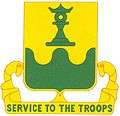 519th MP Battalion, OPCON to the 193d Infantry Brigade; deployed to Panama the week before JUST CAUSE from Fort Meade, Maryland.
519th MP Battalion, OPCON to the 193d Infantry Brigade; deployed to Panama the week before JUST CAUSE from Fort Meade, Maryland.
- 209th MP Company
- 401st MP Company
- 511th MP Company
- 555th MP Company
- 988th MP Company- arrived in Panama on 14 Dec 1989 and was the 1st MP company to receive combat orders since Vietnam
- 108th MP Company (arrived D+1 as part of the reinforcing airflow)
 One company, 75th Ranger Regiment, OPCON on D-Day for the purpose of clearing the Commandancia.[8]
One company, 75th Ranger Regiment, OPCON on D-Day for the purpose of clearing the Commandancia.[8] One Marine LAI platoon (LAV-25s) OPCON to the 193d Infantry Brigade from TF Semper Fi.
One Marine LAI platoon (LAV-25s) OPCON to the 193d Infantry Brigade from TF Semper Fi.
Note that TF Bayonet had neither an organic forward support battalion nor normal combat service support units, as was doctrine at the time. Limited support was provided by the 41st Area Support Group (which had theater-wide responsibilities), but lacking a dedicated Forward Support Battalion, the Brigade's logistical support operations were significantly strained.[9] A fifth maneuver battalion had originally been slated for TF Bayonet, for the purpose of having a two-battalion attack at the Commandancia – which was to be the main attack of JUST CAUSE.[10] However, JTF-SOUTH reallocated this battalion to the other side of the Isthmus.[11] Ironically, as JTF-SOUTH was doing this, Noriega was beefing up defenses at the Commandancia. Half of the PDF 6th Company, most of the PDF 7th Company and elements of the PDF Bn 2000 were moved to the Commandancia in the two months leading up to JUST CAUSE, replacing the unit that had led the second coup attempt.
At 1800 hours, 19 December 1989, TF Bayonet received from JTF-SOUTH the order to execute Operation JUST CAUSE, with an H-Hour of 0100 hours, 20 December. Because the JUST CAUSE OPLAN had been classified at the top secret level, only a small number of the Brigade's leaders were familiar with its contents.
After combat operation ceased, a political decision to rapidly drawdown US forces to their pre-invasion levels had an unexpected impact on the 193d; in order to reach that level, USSOUTHCOM directed that the Brigade's field artillery battery be inactivated and its personnel – and their families – be immediately shipped out of country. During this period TF Bayonet became what is believed to be the largest combat brigade-sized unit in post-WWII history, controlling at one period seven infantry battalions – just two shy of what a full division commanded at the time. It managed this task – over the extreme distances noted above – without the benefit of a dedicated support battalion, and the logistical improvisation required was little short of genius.
Within several more months, the rest of the augmentation forces were withdrawn. The 193d Infantry Brigade however, remained in Panama and continued to provide a military presence. On 14 October 1994 after more than 32 years of providing ground defense for Panama, 193d Infantry Brigade was 'honored' as the first major unit to inactivate in accordance with the Panama Canal Treaty of 1977, treaty implementation plan, which mandated U.S. Forces withdrawal from Panama by December 1999.
Current mission
On 31 January 2007, the 193rd Infantry Brigade was reactivated at Fort Jackson, South Carolina with the mission to conduct basic combat training for new entrants to the Army. It has replaced the 171st Infantry Brigade in this task; however, both the 193d and 171st (inactivated 10 June 2016) have a headquarters and personnel on post.
- Headquarters & Headquarters Company
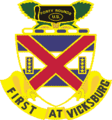 1st Battalion, 13th Infantry
1st Battalion, 13th Infantry 2d Battalion, 13th Infantry
2d Battalion, 13th Infantry 3d Battalion, 13th Infantry
3d Battalion, 13th Infantry 2d Battalion, 60th Infantry
2d Battalion, 60th Infantry 3d Battalion, 60th Infantry
3d Battalion, 60th Infantry
Campaign participation credit
- World War II
- Central Europe
- Combat Infantry Brigade – streamer
- Operation Just Cause
- Panama
Notes
- ↑ The 193rd Infantry Brigade
- ↑ Ronald H. Cole, Operation Just Cause: The Planning and Execution of Joint Operations in Panama, February 1988-January 1990, DIANE Publishing, 1996. ISBN 0788135570
- ↑ Cole, Frederick (Bill) (30 April 2011). "4th Missile Bn (Hawk-AW) 517th Artillery Panama Canal Zone". www.517thartillery.org. Retrieved 28 June 2011.
- ↑ JTF-SO (XVIII Airborne Corps) OPLAN 90-2, dtd 3 Nov 1989, para 3.c(6) Tasks to TF Bayonet; Annex C, Operations
- ↑ Army Lineage Series, Maneuver And Firepower, The Evolution Of Divisions And Separate Brigades, pg 402
- ↑ JTF-SO (XVIII Airborne Corps) OPLAN 90-2, dtd 3 Nov 1989, Annex A, Task Organization
- ↑ 193d Infantry Brigade OPLAN 9–89 (BLUE SPOON), Annex A, Task Organization
- ↑ Summary – Operation JUST CAUSE – 193d Infantry Brigade (Light) (TF Bayonet), pp 9–10
- ↑ Summary – Operation JUST CAUSE – 193d Infantry Brigade (Light) (TF Bayonet), pg. 10
- ↑ JTF-PM OPLAN 7–88 (BLUE SPOON), para 3 Execution; Annex A, Task Organization
- ↑ JTF-SO OPLAN 90-1, dtd 14 Sep 1989, Annex A, Task Organization
References
- "The history of the 193rd Infantry Brigade"
- "The Brigade: A History, Its Organization and Employment in the US Army"
- 193rd Infantry Brigade
- Summary – Operation JUST CAUSE – 193d Infantry Brigade (Light) (Task Force Bayonet), dtd 31 January 1990.
- TF Bayonet S-3 (Operations) Staff Duty Journal, 190001 December 1989 – 152359 January 1990.